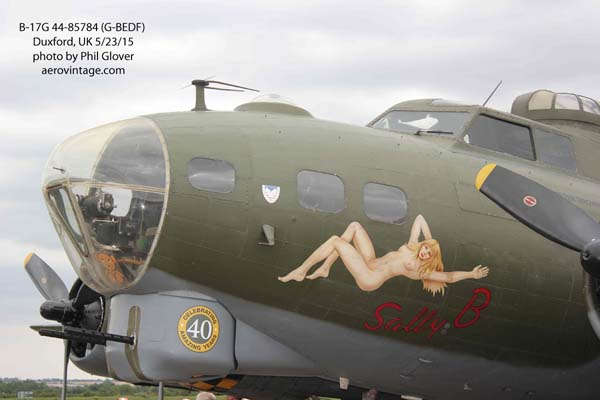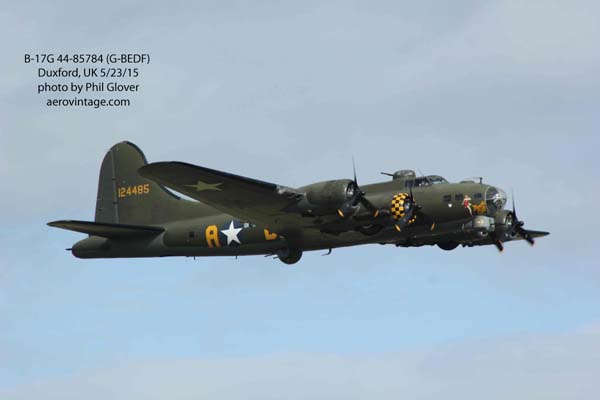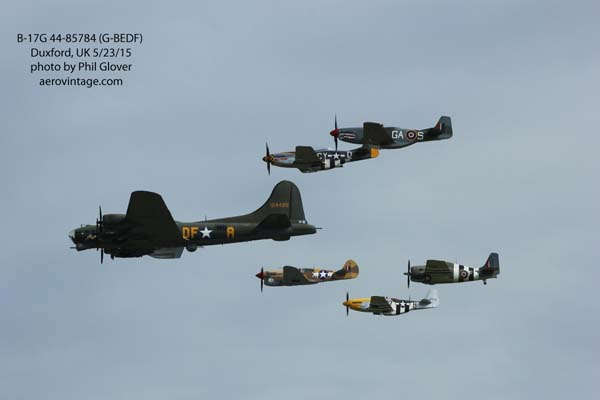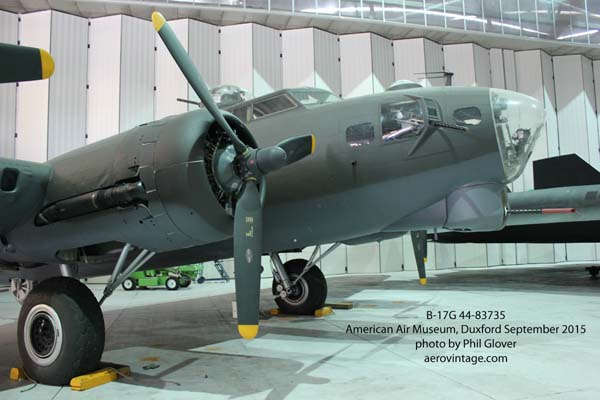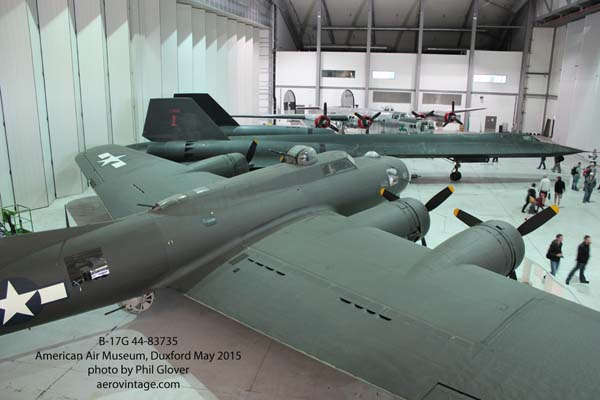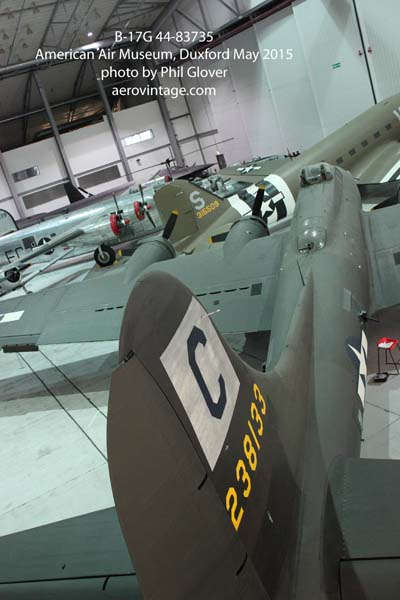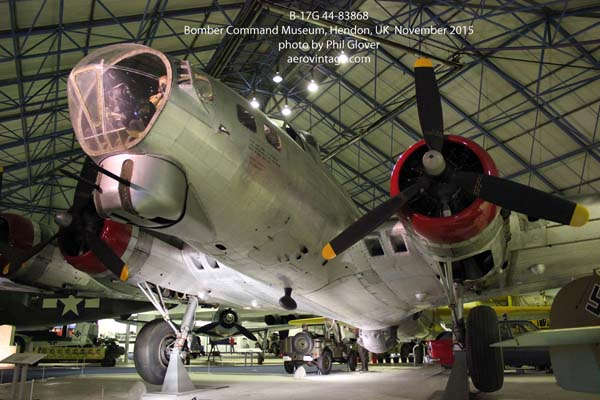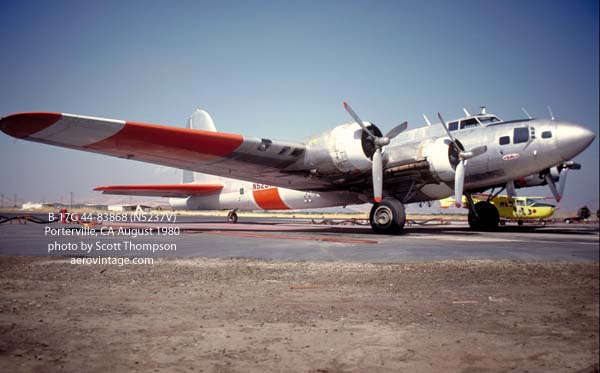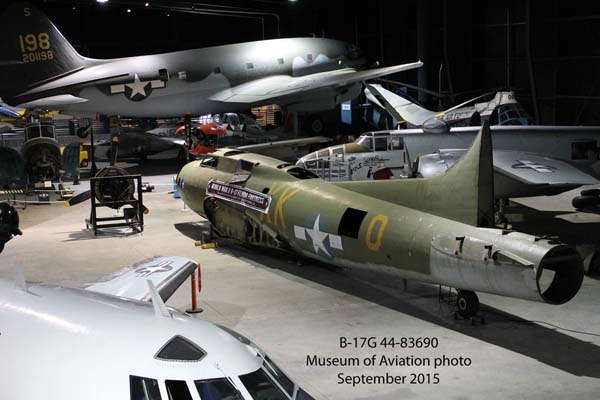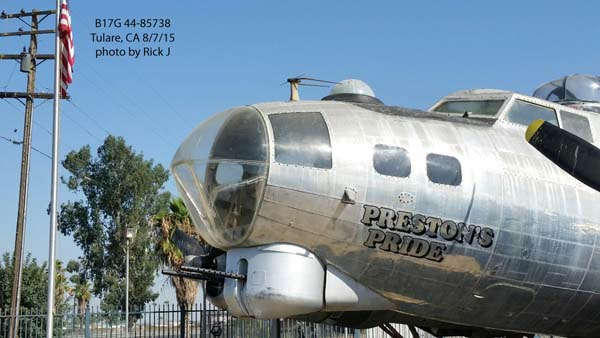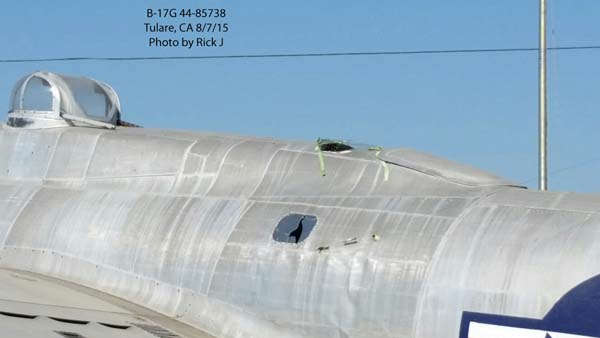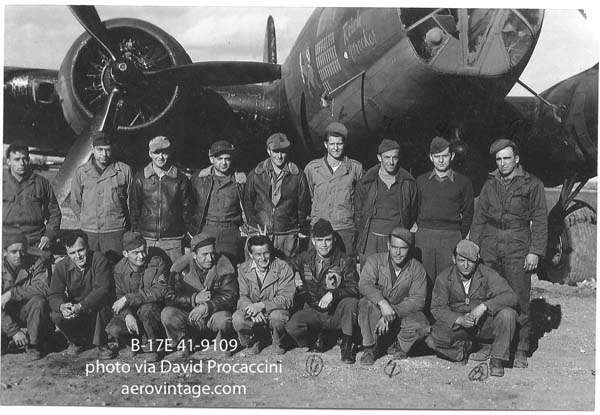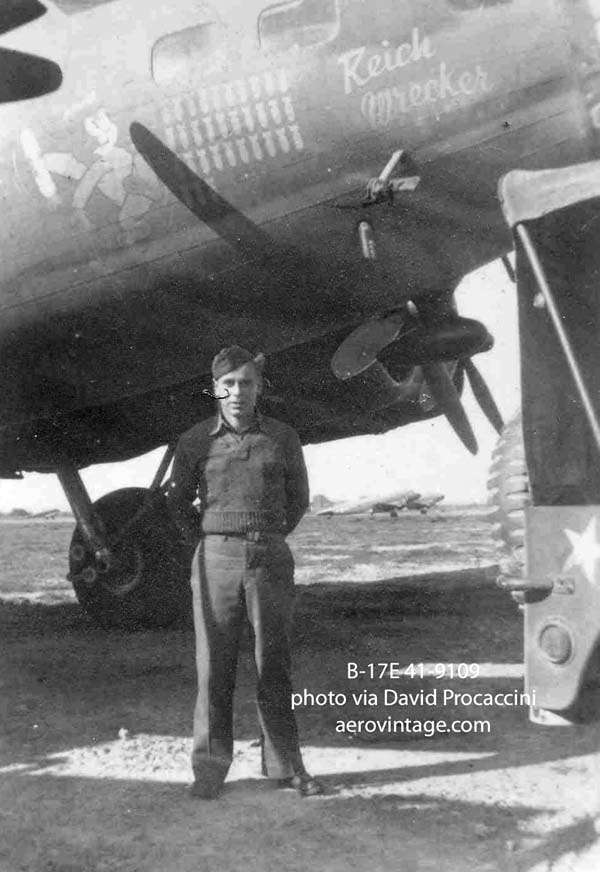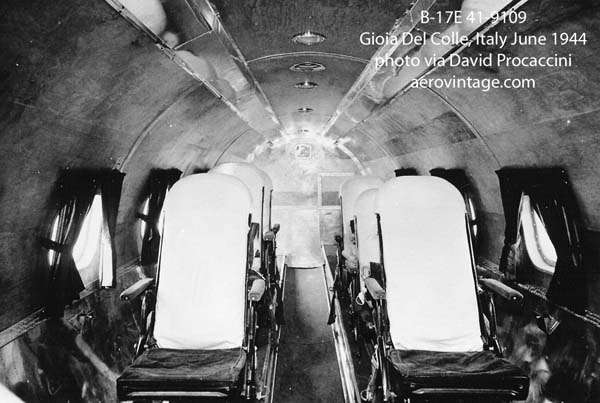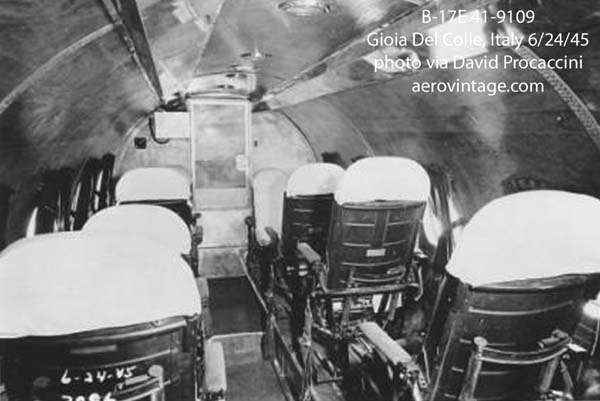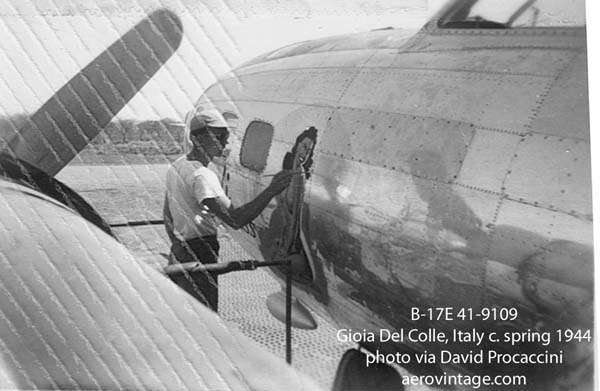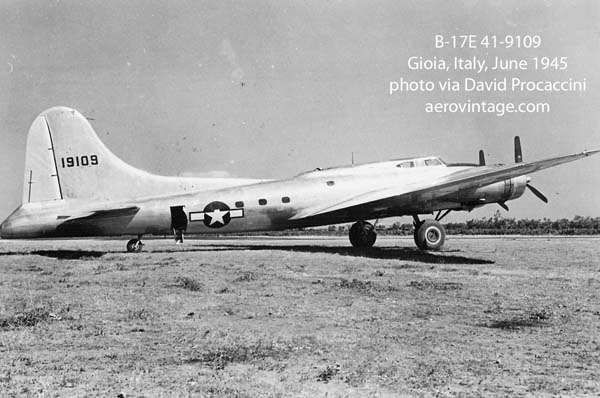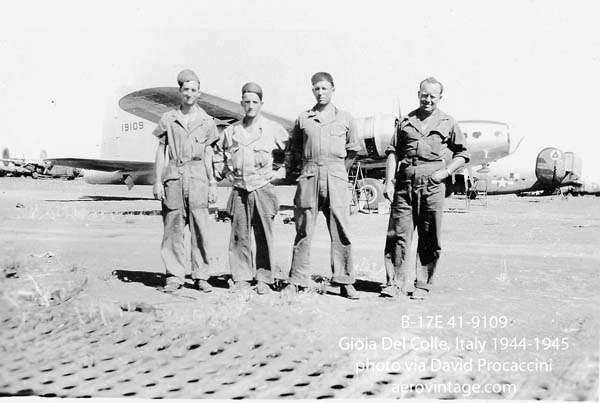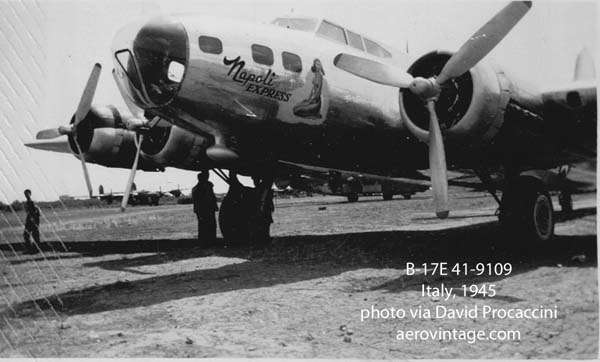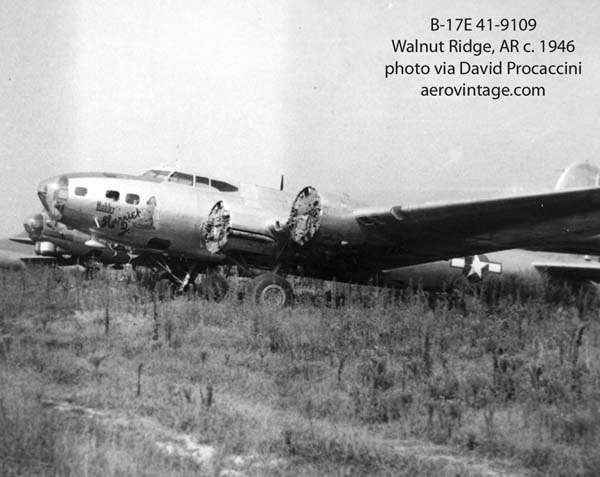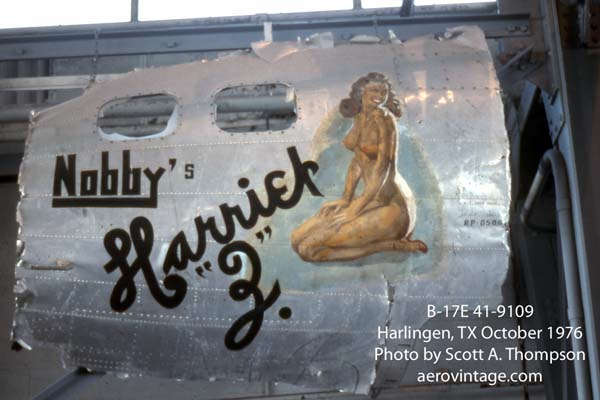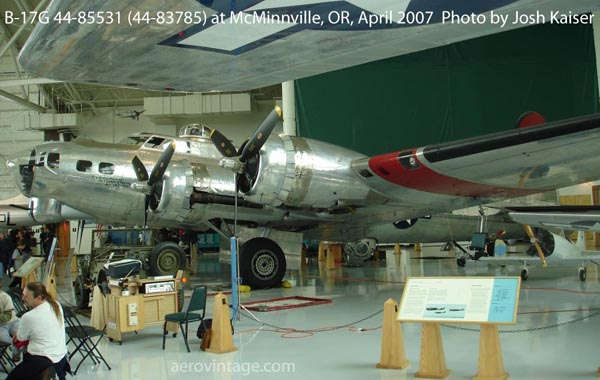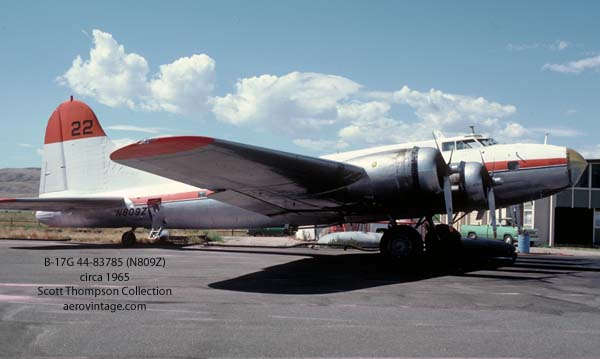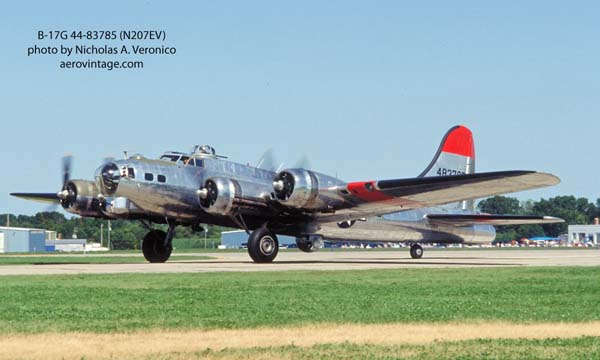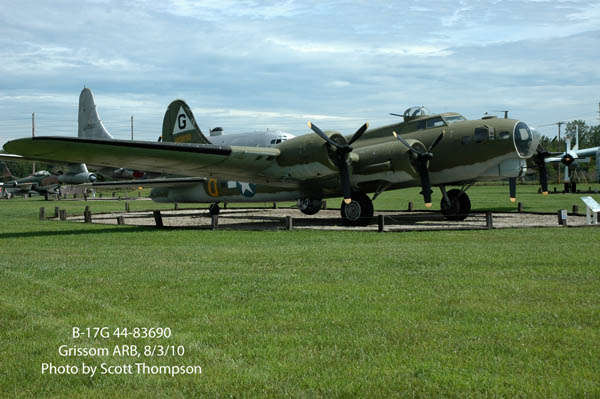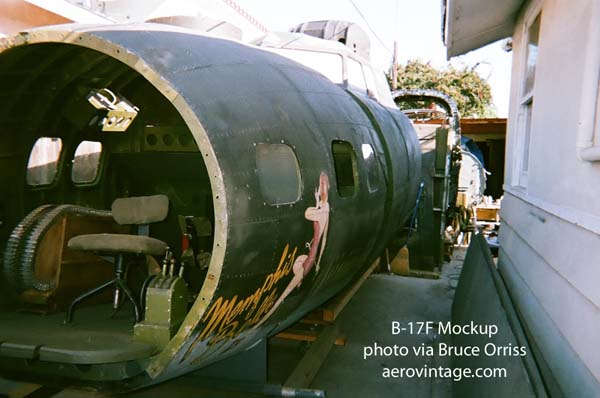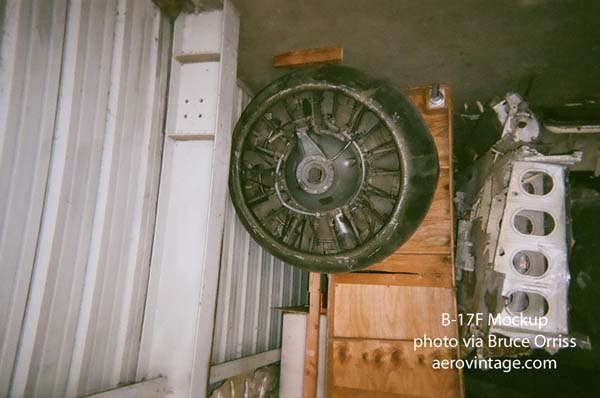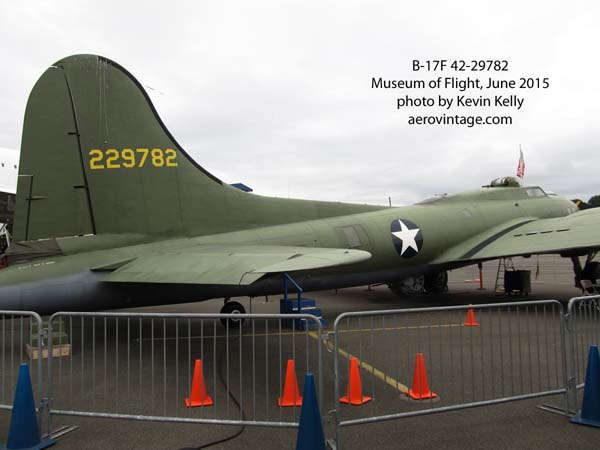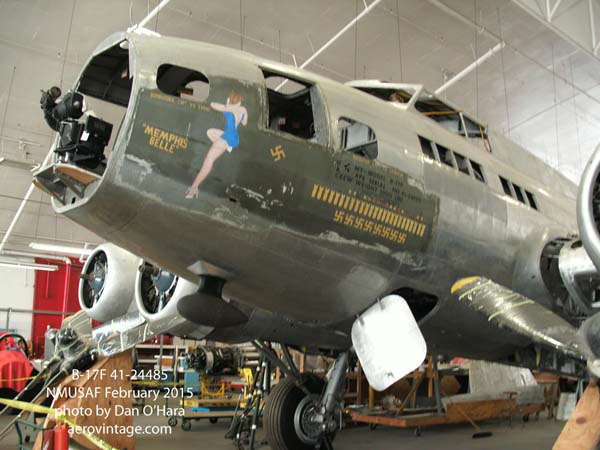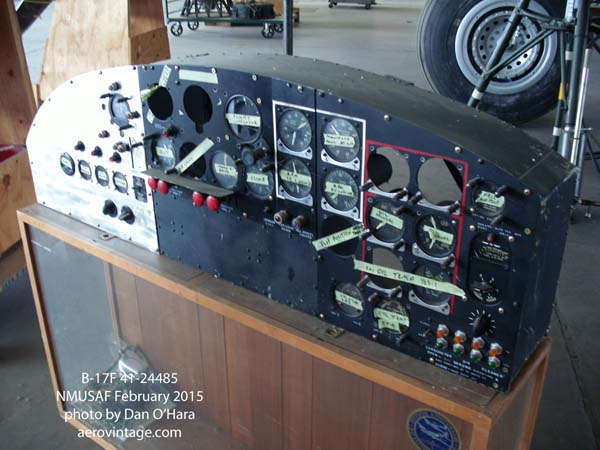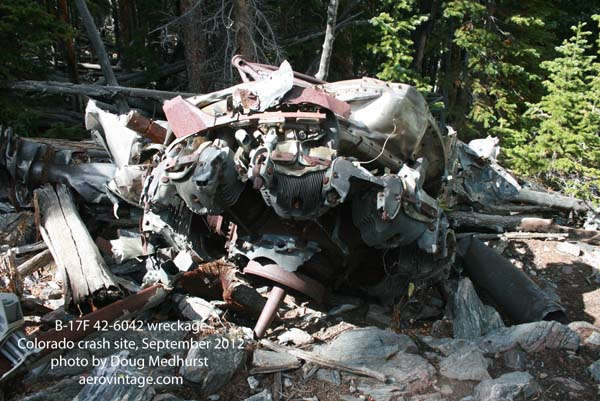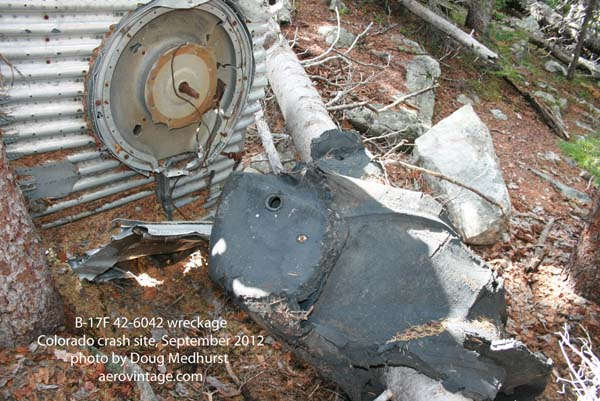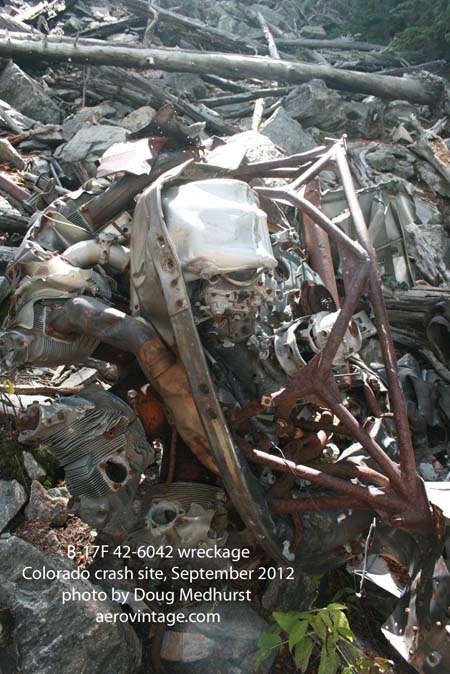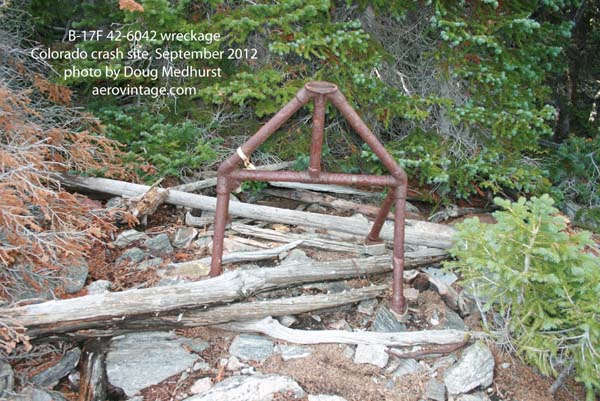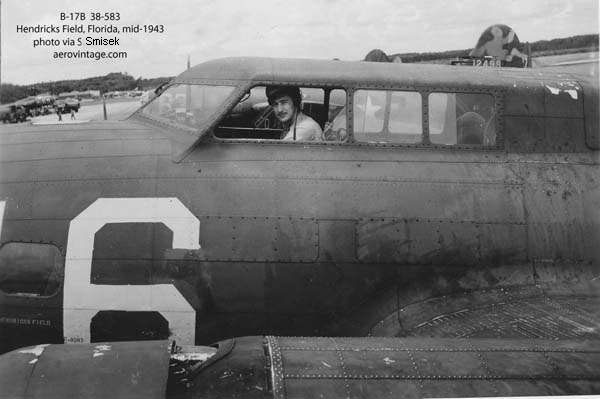
| site search by freefind | advanced |
AERO VINTAGE BOOKS
2015 B-17 NEWS
B-17 News Archive
2018 B-17 News
2017 B-17 News
2016 B-17 News
2015 B-17 News
2014 B-17 News
2013 B-17 News
2012 B-17 News
2011 B-17 News
2010 B-17 News
2009 B-17 News
2008 B-17 News
2007 B-17 News
2006 B-17 News
2005 B-17 News
2004 B-17 News
2003 B-17 News
2002 B-17 News
1997-2001 B-17 News
Back to the Main Page
We're including this page as an update point for B-17 news. We'll post information garnered from any variety of sources, and notate that source at the end of the item. If anyone has anything they'd like to add, please let us know.
B-17 Tour Information
- The Liberty Foundation has tour dates with the leased mock Memphis Belle, 44-83546 (N3703G). It is on winter break right now but is scheduling 2016 dates. Check out the most current information here.
- The Collings Foundation B-17G Nine-O-Nine, 44-83575 (N93012), is on winter break and undergoing annual maintenance in Florida. For the most current information, jump to here for schedule information.
- The Commemorative (ex-Confederate) Air Force's B-17G Texas Raiders, 44-83872 (N7227C), has schedule dates posted. Jump to here for show dates and ride information.
- The CAF's other B-17G, Sentimental Journey, 44-83514 (N9323Z), has no tour dates currently scheduled but offers rides on a pre-arranged basis from its Mesa, Arizona, base. The Arizona Wing's page can be found here for the only Wing information posted for Sentimental Journey.
- The Experimental Aircraft Association's B-17G Aluminum Overcast, 44-85740 (N5017N), has 2016 dates posted. Check for the most current information here.
- The Yankee Air Force out of Willow Run, Michigan, operates the magnificent B-17G, 44-85829 (N3193G), Yankee Lady. Jump to here for their most current information.
December 2015
- Ferry Flight in Future for Shady Lady?: The Collings Foundation website has posted a bit more information about its acquisition of B-17G 44-83785 (N207EV) from Evergreen, and states that the airplane will, after undergoing a 'a detailed inspection and restoration to flight-worthy status,' join the annual Wings of Freedom tours. Other information gleaned from the American Aero Services website suggests the B-17G will be brought to company's facility at New Smyrna Beach, Florida, for that heavy maintenance work. American Aero Services does the annual winter maintenance on the Collings fleet, including B-17G 44-83575 (N93012), a process that is underway as this is being written. After the active Collings bombers and fighters depart on the 2016 tour, an effort will then be made to get the Evergreen B-17 flyable and ferried to Florida. From the vantage of not really knowing the details, that will probably take quite a bit of work from both the mechanical and paperwork ends. The airplane has not flown for about fifteen years. Hopefully the engines were pickled properly before the airplane was parked. Aside from that, there is a significant airworthiness directive that will have to be addressed eventually, one that will probably require the wings to be demated from the fuselage but, presumably, a ferry permit would allow the airplane to be moved to Florida for that work. So, we may see the airplane informally known as Shady Lady fly once again late this coming winter or in the early spring of 2016. We watch with interest.
- B-17G Nine-O-Nine In Maintenance: And, speaking of American Aero Services and the Collings Foundation and B-17G 44-83575 (N93012), better known as Nine-O-Nine, here is a photo of the airplane in November undergoing aforesaid annual maintenance at the New Smyrna Beach, Florida, facility. Like I said, heavy maintenance.
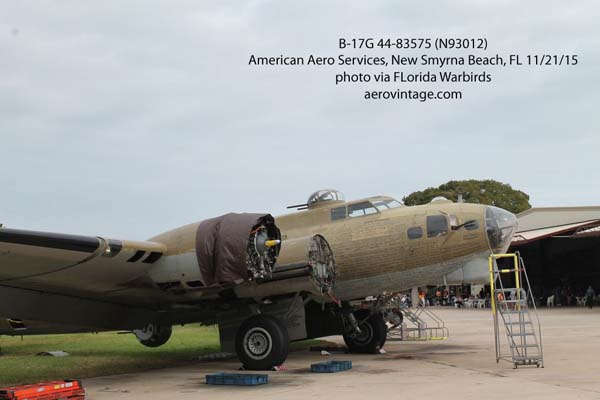
Should be ready to go on tour again in January. Thanks to Matt at Florida Warbirds for the photo.
- Filming the B-17 Scene in Thunderball: And, speaking of B-17G 44-85785 (N207EV), back in the day when it flew for Intermountain as N809Z it was used to film a scene used at the end of the 1965 James Bond movie Thunderball. The well-known scene (to B-17 guys anyways) shows the B-17G and the Fulton Skyhook to good advantage.
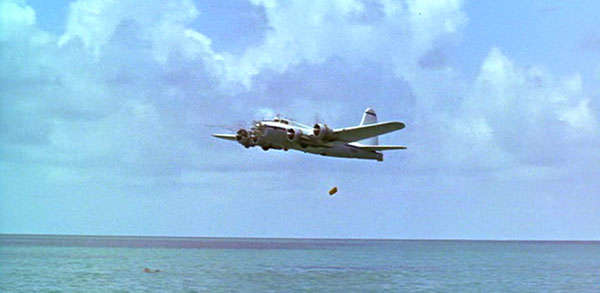
Well, J.D. Davis sent me a link that gives a bunch of, before this, unknown details about filming that sequence in the spring of 1965 at Key Largo revealing, among other things, that the pilots flying the B-17 were Dave Schas and Bob Zimmer, and there were a few exciting moments with landing gear issues after the scene was completed. It is an excerpt from, I believe, the April 2011 newsletter of the National Smokejumper Association and is an account written by Tony Beltran. I have cut and pasted together an easier to read copy of the article which you can read right here. Good stuff; not sure how JD finds these things but he continues to unearth some good information.
- Please Don't Let This Be Nose Art For 'Swamp Ghost': The aviation online news source AVweb reports here that artists at Disney Animation created "unique nose art" for B-17E 41-2446 that is currently displayed at the Pacific Aviation Museum at Ford Island, Hawaii.

According to the AVweb story, the museum had a gala event the first weekend of December and announced the project, cited as the first collaboration by Disney for nose art since World War II.
From the distance, here is one guy who hopes there is no intent of actually applying this fanciful creation to the rare and unique B-17E, either in its unrestored condition or any other condition. Editorially speaking, the airplane was never named Swamp Ghost and never had nose art applied. That name has only become informally attached to the airplane over the decades it sat, unrecovered, in a remote New Guinea swamp.
Despite the gala event, we are hoping that this new image will only be seen on letterhead and fundraising material used to pull together a proper display for this war veteran B-17 in the museum. For what it is worth, I come down on the side of leaving this airplane correctly reassembled and preserved, but otherwise unrestored, and displayed as such. It is a snapshot in time best left alone.
- UK Update #1: English guy Phil Glover noted an absence of some good information on those B-17s 'over there,' particularly the one that is still flying, so he sent in a bunch of great photos and information on their current status. The flying one would be B-17G 44-85784 (G-BEDF), better known on both sides of the ocean as Sally B, which is currently celebrating forty years of operation by the group now known as B-17 Preservation Ltd.
Note the sticker proclaiming Celebrating 40 Amazing Years applied on the side of the chin turret for the 2015 flying season.
It was back in 1975 that the late Ted White acquired this B-17G from France’s Institut géographique national where it had operated as a survey platform for two decades plus. In the ensuing years there have been many ups and downs for the airplane and the organization, including a starring role in the 1989 filming of Memphis Belle and, for a recent few years, a series of frustrating, expensive, and maddening engine failures. Things have gotten on track in the past few years, though, and the airplane soldiers on. These photos were taken by Phil at the VE-Day Airshow at Duxford, the B-17s home base, on May 23, 2015. Note that the right side markings are similar to those it wore in the filming, an accurate representation of that B-17F save the chin turret and a few other little details.
It is much worth checking out the organization's website seen right here for more about the history of both this airplane and the organization run by the airplane's namesake, Elly Sallingboe.
Nothing like a B-17 leading a pack of fighter down the airshow line. I figure there is, like, 11,000 horsepower and about $15 million in this photo, mate.
- UK Update #2: Another of the UK B-17s is B-17G 44-83735, held in the collection of the American Air Museum, also at Duxford. This airplane has been off and on display at museum several times over the past few years as the museum facility itself undergoes some maintenance. The B-17G, which also last flew with the French Institut géographique national as F-BDRS, was pulled off the main display floor back in April 2011 for refurbishment. When it was subsequently repainted, it lost its name of Mary Alice and, at this time, remains unnamed.
Last year it was briefly placed back on display, and then was pulled again and put back into storage in another hangar while the museum building was worked on. It was placed on temporary display this past summer and Phil Glover sent in some photos of the airplane.
Phil reports the paint is a bit splotchy and uneven, but that may not really be a bad thing, as the production B-17s are often seen with somewhat splotchy and uneven paint out of the factory. The airplane looks a bit naked, ironically, without a name or nose art applied, but this is also a bit refreshing to me as it, once again, suggests a typical B-17 fresh off the production line.
It carries the (new) tail serial of B-17G 42-38133 (the tail serial it carried as the Mary Alice was 42-31983). Why the switch, and why that particular tail number? Unknown to me, but 42-38133 was an early Douglas production B-17G delivered in December 1943 that flew with the 96th BG, had no known name or nose art, and was lost in action in 1944. The 96th BG assignment is also reflected in the 'square C' tail marking.
Word on the street is that the museum is hoping to interest a U.S. bomb group association in sponsoring the airplane upon which time it will be marked in that group's markings.
The revised American Air Museum is slated to reopen for business in May 2016 at which time the B-17G will be back on display.
- UK Update #3: Well, maybe not so much an update as a report that B-17G 44-83868 is still on fine static display in the Bomber Hall at the Royal Air Force Museum located in London.
This ex U.S. Navy PB-1W airborne early warning aircraft and ex Butler Aviation air tanker came to the museum collection back in 1983, shortly afterwards lost its low time engines in a swap with Sally B, was painted in 94th BG markings (with no name or nose art), and placed on display in the museum gallery. And there it has sat for the ensuing 3.5 decades.
Here is a 1980 view of the same aircraft on the fire lines at Porterville, California, when operated by Butler Aviation. For all the young folks, that was back when tankers had propellers and tailwheels.
Thanks to Phil Glover for sending in these updates. I've also updated the B-17 Locator page with updated photos of these three airplanes.
November 2015
- Museum of Aviation B-17G Indoors: As noted in the July 2015 update, B-17G or, more properly, DB-17P 44-83690 was transferred by the NMUSAF from the Grissom Air Museum in Indiana to the Museum of Aviation located at Robins AFB, Warner Robins, Georgia. It was disassembled and transported by truck, arriving at its new home in late August.
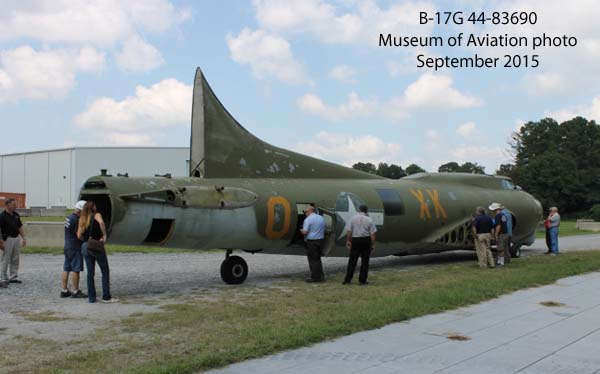
It has since been moved into the 60,000 square foot main museum exhibit hangar where it will enjoy a static restoration over the next few years. The airplane had been on outdoor static display since the USAF retired the modified drone director DB-17P in 1960, and it has suffered greatly when measure by corrosion and airframe damage. It is externally complete, however, and will be on public display in the museum as workers reassemble and restore the airplane.
Here is a link to the museum's web page dedicated to the restoration project.
- Tulare B-17 Gets New Nose: Rick J reports that the Tulare B-17G (also an ex drone director DB-17P) 44-85738 had a new (but actually well used) Plexiglas nose piece installed this past spring. This airplane has suffered much over the course of over five decades of outdoor display alongside Highway 99 in the central valley town of Tulare, and the old nose sort of rotted of a few years ago, temporarily replaced with a canvas sheet and later a flat piece of Plexiglas. The AMVETS group that is the caretaker of the airplane was able to secure a used nose piece for a couple hundred bucks to replace the old one. They noted that a new blown nose would cost in the range of $15,000, so this was the only viable solution for a sponsor group with limited means. This new nose has a large crack up one side that is covered with tape.
The display appearance of the airplane has gone up and down over the years. It is in a bit of downward mode right now, with unrepaired truck damage to a wingtip, broken glass, and a rippled airframe mid-section, the cause of which is hard to discern.
Rick J enjoyed some correspondence with the AMVETS group about the airplane which I won't quote here. Suffice it to say the sponsor group continues to attempt to maintain the airplane with the very limited means it has available which, frankly, is not enough. The NMUSAF controls the fate of this airplane and one does wonder if at some point it will be redirected to a sponsor group that will be able to move the airplane indoors and at the very least repair it and restore it to display status. Thanks to Rick J for following up and keeping me in the loop.
- Israel Still Wants a B-17: An article appeared in the August 13, 2015 edition of the Jerusalem Post about the L.A. restaurant The Proud Bird but it also mentions an Israeli museum trying to acquire a B-17 for its collection. I'll quote the pertinent parts here as the hyperlinks have a habit of going away.
In a kind of Israeli “postscript” to the B-17 story, Orriss also owns a B-17 and is restoring it for the Israeli Air Force museum. “Israel had three B-17s in 1948,” he said, “and they acquired them clandestinely as cargo airplanes with the intention to use them as bombers. “But to get them out of the United States, they said ‘Oh, we’re going to use them for cargo.’ They got the three out and managed to get them to Czechoslovakia and then down to Israel.” But the fourth bomber didn’t quite make it because the US government had figured out what was going on. So the Israelis got as far as Canada, where the authorities “grabbed them and put them in jail temporarily.” The Canadians, according to Orriss, said “OK, we’re going to let you go, but you got to promise to turn around and go back to the United States.” Once in the air, the Israeli pilots did turn around – but not in the direction of the US Instead, they headed out across the Atlantic and managed to get all the way to Portugal, where the Portuguese stopped them and then let them go – but without the B-17.
Readers of these pages are familiar with Bruce Orriss for his work with B-17s and aerial movie history. References in this article appear to refer to B-17G 44-83387 that Bruce has been involved with for decades and which now the forward fuselage now resides with the Liberty Foundation in Georgia. Other parts are apparently being incorporated into a static restoration eventually bound, maybe, for Israel. The Israelis have for years been trying to get a B-17 for its aircraft collection and many deals have fallen through. Perhaps this one, not.Israel retired its B-17s in the early 1960s, two being turned into scrap and the third sent to England for interior scenes in the Steve McQueen movie, 'The War Lover.' “The Israeli Air Force museum had been looking for a B-17,” Orriss said, “and they found out I had one. So we’ve been rebuilding it ever since and hope to be finished with it by next year.” Orriss first saw this B-17 in 1966 at the old Fox movie studios on Melrose Avenue in Los Angeles while it was being used for the Twelve O’clock High TV series. Back in 1949, it had also appeared in a feature film of the same name starring Gregory Peck. By the mid-1970s, 20th Century Fox auctioned the plane off, and it ended up decorating a bar in Colorado, where Orriss later purchased it from the bar owner. “When I think about it,” Orriss said, “it’s a crazy story because I saw that airplane when I was 18, and I have stayed in touch with it all these years. It’s like a personal relationship with the airplane.” And all those wonderful, other old airplanes at The Proud Bird – they’re also the stuff out of which many lasting, personal relationships are indeed made.
Thanks to Aad van der Voet for passing this along.
- Story of a B-17E: Back in July (2015), I posted an image sent in to me by Steve Birdsall that showed some interesting modifications done to a B-17E at a aircraft depot in Italy. Well, I got a bunch more information on this airplane from David Procaccini who has done some extensive research. David is the unit historian for the 38th Air Depot Repair Squadron, the unit David's grandfather was assigned to and the unit that the history of this airplane revolves around.
So, this is a very long story but I think an interesting story and should be told somewhere, so if you are interested in such things, grab a cup of coffee and peruse this tale...
The story starts on April 15, 1942. The U.S. was barely four months past Pearl Harbor. The Japanese expansion in the Pacific was unchecked and the meager Allied forces fighting the onslaught could not even sustain a holding action. For the American efforts in the Philippines, the U.S. and Filipino forces had surrendered at Bataan just the week before, and the Bataan Death March was underway. The British had lost its colonies at Hong Kong and Singapore, and the Dutch were being forced out of Indonesia. New Guinea and, further south, Australia, were under the threat of invasion by the Japanese. In Europe, the infant Eighth Air Force was just beginning to pull together its headquarters structure in England, but the first combat groups were months away from arriving. Every commander of every combat unit demanded priority for manpower and supplies due to the critical situations being faced everywhere.
Into all of this rolled a brand new B-17E, s/n 41-9109, which came off the Boeing production line in Seattle that mid-April day, the 376th of the 512 B-17Es built by Boeing. The Air Corps (not yet the Army Air Forces) slated this new B-17E to go to the 97th Bomb Group hurriedly being formed at Sarasota, Florida, as one of the first bomb groups to go to England. It and a number of other new B-17Es were quickly diverted, however, to instead go to the Southeast Pacific as replacement aircraft for combat bomb groups, either the 19th or 7th, then engaged in a desperate fight to stop the Japanese expansion from bases in Java and Australia. The sketchy information available suggests it was ferried via the South Atlantic ferry route from Florida to Brazil to the west coast of Africa and up through to the Middle East and on to India, from where it would stage to Australia. It never got beyond India, however, as when 41-9109 arrived in Karachi, India in early May 1942, the 7th Bomb Group had already evacuated from Java and was reforming at Karachi. It appears 41-9109 was then assigned to the 7th Bomb Group, and may have begun combat action by flying missions against the Japanese in Burma or China, though the account of this action remains incomplete. A month later in mid-June, though, it appears that 41-9109 and the remaining small fleet of B-17s in the 7th Bomb Group, totaling nine aircraft, were detached and moved to the Middle East to support the British in desperately defending Egypt from a pressing German offensive by the Afrika Korps.
This small group of B-17s and a small group of similarly diverted B-24s, all under the command of Gen. Louis Brereton, became the nucleus of the U.S. Middle East Air Force. The B-17s, technically assigned to the 9th Bomb Squadron and later the 1st Provisional Bomb Group, were based at Lydda in Palestine and conducted bombing missions against Tobruk and other German targets in Libya. Again, it is not clear whether or not 41-9109 was part of this small group of B-17s but the time line fits the scant information available from the aircraft record card. In November 1942, the 9th Air Force was established and took overall control of the U.S. air efforts in the Middle East. There were still a handful of B-17s operating from Palestine, but replacements coming in were the longer-range B-24s. The bombers were soon moved forward to bases in Egypt to support a British offensive moving westward across North Africa. And, that same month, the TORCH landings were made in Algeria, supported by the new 12th Air Force, and a second front was established pushing eastward across North Africa, with the embattled German Afrika Corps increasingly squeezed between the two efforts.
The record card for 41-9109 indicates it was assigned to the 12th Air Force in January 1943, apparently sent from Egypt to Algeria and a bomb group there. It is possible that the few remaining B-17s based in Egypt were reassigned at this time to standardize on the longer-ranging B-24 for operations from Egypt. With what bomb group and from where this B-17E was based has not (yet) been definitively uncovered, but presumably it continued flying missions against the Germans from a base in Algeria through 1943. At some point, photos show the airplane gained the name Reich Wrecker with nose art.
The 12th Air Force only had two heavy bomb groups attached to it: the 301st BG and the 97th BG, so presumably it was assigned to one of them. Having information that seems to exclude it from being assigned to the 301st BG, it is probable that it ended up with its original earmarked unit off the Boeing production line, the 97th BG. Records are scant, however, so it is hoped that more information will surface. From the photos available, 41-9109 flew at least thirty-three combat missions and probably many more.
When the 15th Air Force was established in Tunisia in November 1943, both of the 12th Air Force bomb groups were reassigned to the new unit, and the aircraft record card does show it assigned to the 15th AF. In December 1943, the 97th BG was moved forward to Cerignola Airfield at Foggia in Italy, and began operations there against targets in northern Italy and southern Europe and, presuming this aircraft was assigned to that group, it moved with the group. However, how long this by-then war weary B-17E remained assigned to combat when much improved B-17Fs were available has yet to be determined but, presumably, it was out of combat duty by the end of 1943.
At this point, thanks to research by David Procaccini, a narrative of the aircraft's story is picked up by Capt. Robert E. Johnson, Engineering Officer with the 38th Air Depot Repair Squadron based at Capodichino airfield at Naples in Italy. He tells the story that the B-17E was flying a combat mission 'over Europe' and that this B-17 had a load of anti-personnel bombs dropped on it from an aircraft flying above in formation, and that some of the bombs hit and were embedded in the left wing of the B-17E. The crew feared an imminent explosion but nonetheless elected to try and fly the airplane back to base, but later decided to land at the Pomligiano airfield near Naples, then a fighter and light-bomber base. After landing, a bomb retrieval squad removed the bombs and made the airplane relatively safe. The 38th Squadron was assigned the task to repair the airplane but after evaluation of the damage and considering the war-weary condition of the nearly obsolete B-17E, recommended it for salvage. The unit commander, however, overruled that assessment, feeling that 'we were salvaging too many repairable airplanes.' A crew under the direction of Sgt. Curtis Foster was assigned the months-long task of repairing the airplane. It was then released back to service and departed Pomligiano to a destination and assignment unknown but, in fairly short order, probably by March 1944, it ended up at a storage yard for war-weary bombers at the 38th Air Depot at Gioia Del Colle Air Base in southern Italy.
The men of the 38th Squadron at the depot unofficially adopted the B-17E and decided, on their own, to convert it to be used for squadron transportation. From the accounts, the unit was sufferning from low morale and had been subjected to unearned derision by local commanders, so the assumption of the project appears to have been an effort by the men in the unit to show what they could do.
And, they did a lot to the old and tired B-17. Besides the mechanical work required to put the airplane back into good condition, the airplane was stripped of all combat gear including turrets and gun mounts and armor. Extra windows were cut into the fuselage, including the two odd-shaped windows behind the cockpit. The tail gunner compartment was rebuilt and faired over. Note in the photo below, the templates for the aft cockpit windows appears to be taped in place.
Into the stripped out fuselage went plushed-out (used loosely) accommodations for passengers. The installed seats were salvaged from nearby war weary B-24s, and the seat covers were made by the parachute guys. Whatever was needed was scrounged or manufactured or, probably, covertly appropriated. The nose glass was replaced with one from a B-17F, and other custom modifications were made at the suggestions of those working on the airplane.
Note the attention to detail on the interior finish work, something not usually seen in the combat zone. Curtains, even.
The exterior paint was stripped off and the bare aluminum was polished back to a high luster, and standard U.S. markings were reapplied.
The squadron had voted to just call the airplane '109' but a more formal name was felt necessary. The name Napoli Express was soon decided upon, a reference apparently to its use in transportation to Naples. And, a talented squadron artist named Ken Duffin carefully applied a fitting piece of art to the both sides of the nose aft of the painted name, lending a distinctive flair to the completed aircraft.
Dates become a bit fuzzy, because it appears the airplane made its transformation to become this very nice administrative transport probably by mid-1944, but it was not officially transferred to the squadron for use until May 1945. Accounts suggest it was used extensively through the first half of 1945 while based with the 38th Depot at Gioia Del Colle Air Base. In March, the unit was told to stop operating the airplane as it was not assigned to the squadron and was instead consigned for scrapping. The unit nonetheless continued to operate the airplane and made more requests to have the airframe actually assigned to the them.
Finally, on May 15 (1945), the unit got the official notice that "...SINCE AUTHORITY TO SALVAGE B-17E, NUMBER 41-9109, HAS ALREADY BEEN RECEIVED FROM THE FEA, YOUR SQUADRON MAY USE THE AIRCRAFT FOR ADMINISTRATIVE PURPOSES. WHEN AIRCRAFT IS NO LONGER DESIRED IT WILL BE SALVAGED IN ACCORDANCE WITH EXISTING INSTRUCTION." It continued in service with the unit until the end of August.
The 38th Repair Squadron took a great deal of pride in the airplane, and all men in the unit were afforded the opportunity to fly on the airplane, presumably on local flights or in the course of its duties to transport personnel and material to and from Naples and other Italian bases.
Captain Johnson related a story provided to me by David Procaccini, of how his unit, the 38th Air Depot Repair Squadron, had been continuously run down by the overall commanding colonel of the repair group to the point that the colonel eventually dispersed parts of the squadron all over Italy. Johnson ran into that colonel one day at Naples and took the occasion to show him what they had done with the war weary that was now the Napoli Express. The colonel was quite impressed with the B-17E and, in a long conversation, confessed he had been terribly wrong about the 38th Squadron and work at the depot had suffered greatly after he had dispersed them. From the account, Johnson took a great deal of satisfaction in showing the colonel the caliber of the work capable by the men in his unit.
In early September (1945), 41-9109 was ordered to be flown back to the U.S. by a seven-man crew commanded by Capt. James B. Pritchard. The airplane left Naples as Napoli Express shortly afterwards and was, by one account, ferried through Boston along the way.
After its arrival back in the U.S., it enjoyed a short stint as a transport for the Air Transport Command and its assigned pilot was Norbert "Nobby" DeGravelles. He evidently had little appreciation for the name Napoli Express but he did have an appreciation for his current girlfriend, a lass named Harriett and who's last name has disappeared into history, but apparently started with the letter "Z." Soon enough, a new name was painted on the airplane and it became Nobby's Harriet "Z". Fortunately for posterity, the nose art was left untouched for the brief time the B-17E remained in service and, hopefully, Harriet Z. appreciated the honor. It was short lived, though, as on October 10 it was transferred to the Reconstruction Finance Corp. for disposal, and sent to the RFC storage depot at Walnut Ridge, Arkansas. There, it joined 5,600 other war weary bombers and fighters lined up in neat rows across a huge airfield. Its fate was established when it came to Walnut Ridge.
Like its bretheren, it was stripped of engines and propellers and sat for nearly a year before the depot's content was sold, via auction, to the Texas Railway Equipment Corp. for salvage and scrapping. In the subsequent year, over 4,600 surplus bombers and fighters were broken up and smelted, a practice that was repeated on four other large surplus depots across the country. By the end of 1947 they, including 41-9109, were gone.
Ah, but there is a postscript. The story goes that the man in charge of breaking apart the airplanes at Walnut Ridge, a gentleman named Minot Pratt, recognized the great examples of folk art painted on some of the airplanes. He quite unusually chopped out of 34 airplanes the aircraft names and nose art and set them aside before the airplanes were scrapped. One wonders how this passed muster with the corporation that was seeking the aluminum from the airplanes, but these nose panels did somehow survive. And, in the mid-1960s, these panels were donated to the Confederate Air Force, then based at Harlingen, Texas (now the Commemorative Air Force based at Midlands, no, wait, Dallas, Texas).
And there she is, then, the nose panel from B-17E 41-9109, a veteran bomber that had quite a tortured trail through history as the Reich Wrecker and then Napoli Express and finally as Nobby's Harriet "Z".
And, just last month, as the Commemorative Air Force was packing its bags at Midland and moving to Dallas, the nose art collection was placed on loan to the EAA Museum at Oshkosh, Wisconsin. These unique and rare panels, including Nobby's Harriet "Z" will be on display at the EAA Museum.
Thanks to David Procaccini and his sources, Robert E. Johnson and Charlie Sulkala, for much of this material, plus the always valuable help of Steve Birdsall.
August 2015
- Evergreen B-17G Goes to Collings Affiliation: For those following the death throes of the Evergreen group of companies as it proceeded through bankruptcy court, the end has apparently come. As part of the shake-out, the independent, sort of, Evergreen Air Museum located at McMinnville, Oregon, has seen most of its aircraft on display be transferred to new owners. This includes B-17G 44-83785 (N207EV), the ownership of which was transferred from its Evergreen owner, Evergreen Vintage Aircraft, to an entity named FORTRESS AND FIGHTERS LLC, c/o Robert Collings, of Stow, Massachusetts, on July 15, 2015. The B-17G was one of three aircraft (the others are a P-40 and PT-17) that were transferred from the one to the other at about the same time. Other aircraft involved that Collings has obtained but has not (yet, anyways) gone to FORTRESS AND FIGHTERS LLC include a P-38 and an Me-109.
Thus, it would appear that the long-grounded Evergreen B-17G, one with a very storied past, may once again take to the skies. Robert Collings, in a July 30, 2015, radio interview on Warbird Radio, revealed that the current plan for N207EV would be to get it flying by 2017, add it to the Collings Wings of Freedom annual warbird tour, and allow its current B-17G, 44-83575 (N93012), better known as Nine-O-Nine, to receive some long-term maintenance.
The Evergreen B-17G was last flown sometime in 1999-2000 time frame when it was moved to the McMinnville museum from temporary storage at Portland. It has been on static display ever since. Reliable reports have stated that the applicable November 2001 FAA Airworthiness Directive for inspection and repair of wing spar chords, wing spar bolts and spar bolt holes, has not yet been completed on this aircraft, a complicating factor on returning it to the air. Other B-17 inspections conducted in response to this AD led to repair of corrosion and cracking and bolt replacement that required the wings of the aircraft to be demated from the fuselage. One would hope that this will not be the case with the Evergreen B-17.
Much has been written about the history of this aircraft over the years. In a nutshell, this airplane emerged onto the scene in 1961 when it was being operated by Intermountain Aviation, a proprietary corporation run by the U.S. Central Intelligence Agency. In its time before 1960, it has evidently been used by the CIA for covert activities in the Far East while based, variously, at Clark Air Base in the Philippines, on Formosa (Nationalist China), in Japan, and on Okinawa. It was, reportedly, part of a small fleet of black and spooky B-17s used by the CIA and associates for agent insertion and other such tasks.
There remain a number of unsolved mysteries about this airplane, the primary one being its actual identity. When it was first registered with the FAA as N809Z in May 1961, it was identified as Vega-built B-17G 44-85531, another of the known black CIA B-17s. The identification was later corrected and/or changed to Douglas-built B-17G 44-83785, an identity which it retains to this day. The aircraft was scrubbed by its operator of all means of identification, sanitized as it were, six decades ago so there is no definitive way to say one way or another. A close photo examination of 44-85531 taken in 1958 at Clark Field and photos taken of N809Z in 1962 certainly suggest they are the same airplane, but that is not definitive.
Once the airplane emerged into view on the civil register in 1961, it became a bit of an oddity as Intermountain modified it to carry the Fulton Skyhook, a device used for airborne pickup of personnel or equipment from the ground. Such a device could be useful to recover smokejumpers from remote locations, or captured Soviet scientists from an Arctic ice station, or imprisoned CIA B-26 pilots from an Indonesian prison. Things like that. The process and capabilities of the Fulton Skyhook were ably demonstrated on the big screen at the end of the 1965 James Bond movie Thunderball. In the event, the airplane's handlers had big plans for the installation but not much came of it. Or maybe it did.

After its flirtation with adventure, N809Z morphed into a boring old air tanker, a role in which it served for over two decades until about 1980 or so. In the interim, Intermountain was put out of business by Congress and Evergreen assumed the duties, er, ownership of most of Intermountain's assets, including N809Z which, in 1979, became N207EV. (Update: by the way, the date shown in this photo is probably off by ten years or more...it was probably taken in the late 1970s as noted by eagle eye reader Dale D., aka BlueRamTruck, who noted the green Dodge pickup in the photo is 1974-1976 vintage.)
Once retired from the air tanker business, the B-17 languished at the Marana airport in a desolate part of Arizona. Starting in 1985, efforts were made to restore the airplane to a bomber configuration for the air show circuit and was flying about at airshows beginning in 1990. It operated sporadically until 1998 or so, when it was placed into storage at an Evergreen facility at Portland, then moved to the permanent museum at McMinnville a few years later.
All this stuff is well documented in Final Cut, 4th Edition but I don't have any more copies to sell so you will have to take my word for it or buy used copy on Amazon.com.
So, perhaps another chapter in the story of this airplane is now opening.
Betting man's thinking: this B-17G will be made airworthy and possibly operated for a year or two by the Collings Foundation, on a leased basis from its current owner (also Collings), then sold. The value of a B-17 in today's market: unknown but I bet someone would pay upwards of $6 million or more for a flying airplane.
July 2015
- Grissom B-17G On the Move: In May 2015, it was announced that the long-displayed B-17G, 44-83690 and otherwise known as Miss Liberty Belle, would be moving to the Museum of Aviation at Robins AFB, Georgia, in August 2015. The B-17G, actually an ex-USAF DB-17P drone controller, has been on outdoor display at Grissom AFB (formerly Bunker Hill AFB) in Indiana since 1961.
As is the case at most base museums, the condition of the airplane had its ups and downs over the years, but being on outdoor display has taken its toll. The NMUSAF formally owns the aircraft and it was on 'loan' to the Grissom museum. It is now being reassigned to the Museum of Aviation which, reportedly, has indoor display space ready for the airplane. This is a bit unprecedented for the NMUSAF for, aside from the rare B-17F Memphis Belle, it has not taken such action to move one of its displayed B-17s to a new facility that offers better care. Might be the sign of things to come as there are, by my count, eight other NMUSAF-controlled B-17s currently on outdoor display. By my count also, the NMUSAF holds in its museum inventory a total of sixteen B-17s. More changes forthcoming?
In any event, the Grissom B-17 will be disassembled and trucked to Georgia, where it will require extensive work to reassemble and restore. It would appear that the intent is to do an in-place restoration of the airplane while it is on display, similar to the effort made by the National Museum of the Mighty Eighth Air Force, also in Georgia (hey?). There is a fund-raising effort underway by the Museum of Aviation for those who want to help the process along.
- National Museum of the Mighty Eighth Air Force Dedicates B-17G: And, speaking of the National Museum of the Mighty Eighth Air Force, I would be remiss if not mentioning that the six year restoration effort performed on B-17G 44-83814, now known as the City of Savannah, culminated in a dedication ceremony held at the museum in late January 2015. Though the restoration is not 100% complete (will it ever be?), it is essentially complete and a tremendous success story for the museum. The B-17G was received by museum in January 2009 from the National Air and Space Museum after being held in storage for multiple decades. It is now displayed as the centerpiece of the museum. More information on the museum can be found here.
- Update on Recovery of B-17 air tanker wreckage: The planned recovery of parts from the crash site of B-17G air tanker 42-102715 (N66573), perhaps better known as the Batmobile, has been put on hold by team leader Bruce Orriss until the summer of 2016. Details of this recovery are told in the December 2014 B-17 News update. The recovery delay is due to a number of higher priority projects that Bruce is working on (see below).
- B-17F Movie Mockup from Memphis Belle Movie Under Rebuild: The B-17F mockup used in the 1989 filming of Memphis Belle has been moved from Australia to the Los Angeles area where it is being rebuilt for use in a forthcoming film project on the 8th Air Force. Bruce Orriss is heading the group putting the mockup back into filmworthy condition in his shop near the Hawthorne airport.
The mockup is quite extensive and consists of the whole fuselage including the tail stinger, parts of the wings and motorized replica engines. Here is a view of one of the engines.
No doubt due to production confidentiality requirements, Bruce is not able to reveal what 8th Air Force project this mockup will be used for but promises to let us know as soon as he can. Sounds good to us.
- Production of Massive HBO Mini-Series Masters of the Air Moves Forward: The Steven Spielberg-Tom Hanks production of Masters of the Air, the ten part HBO 8th Air Force miniseries, is moving forward with recent reports such as this one indicating locations are being scouted in England for some of the filming. There had been reports of earlier filming in Georgia last year, some involving a flying B-17G that has been rebuilt to appear as a B-17F, but the linked report says that filming has not yet started. Those connected to the project are no doubt tight lipped due to production confidentiality requirements. Not publically known yet is what, if any, actual B-17s are to be or have already been utilized in the filming. Reportedly, the story will center of actual exploits of the 100th Bomb Group. Some sources put the project budget at an incredible $500 million, a number which is hard to believe for even a project of this size, but who knows? Put this one on the back burner for the time being.
- Roof Under Construction at Seattle's Museum of Flight: Construction is underway on a new museum Aviation Pavilion that will provide some protection (finally) for 20 vintage aircraft held in the museum collection including (finally) B-17F 42-29782. The $31 million structure will cover 135,000 square feet, equivalent to the size of two football fields. It is being funded by private donations and is expected to be completed in the spring of 2016. Besides the B-17F, other aircraft to be brought under cover include the B-29, B-47, Boeing 747 prototype, and Concorde SST. Though the facility apparently will remain open-sided and thus not climate controlled, it will provide at least some protection for these aircraft from the somewhat harsh Seattle climate. In recent years, the B-17F has been shuttled from private hangar to private hangar for winter storage, and the B-29 has been encased in a plastic cocoon, neither option suitable for display of very historic aircraft at the airfield where they were conceived and, at least in the case of the B-17, built.
Kevin Kelly sent in a recent photo of B-17F 42-29782 on summer display. It is definitely getting that realistic "aged" look as the flat olive drab paint fades with the weather.
Too bad for an airplane that was once to be the centerpiece of the main indoor museum display. Times have changed.
- Memphis Belle Progress: Dan O'Hara sent in some photos he took in February 2015 of the NMUSAF restoration effort of B-17F 41-24485, better known as the Memphis Belle.
Reports are this project is still making slow progress but no real updates are forthcoming from the NMUSAF.
However, other reports suggest that this airplane may be ready for paint in late 2015 or early 2016 as the interior work is completed. The airplane still remains a year or two away from being placed on display in the museum gallery, but the wait will be worth it. Then, on to the Swoose?
On a bit of a side note, the NMUSAF announced in early May 2015 that the 'Behind the Scenes" tours of the NMUSAF have been cancelled until further notice, so photos such as this might become fewer and further between.
- Colorado B-17 Crash Site Photos: Doug Medhurst provided some photos he took at the Colorado crash site of B-17F 42-6042. This B-17F crashed in October 1943 with the loss of all eight crewmembers aboard. As can be seen, not much is left. Here is an engine.
Here is part of a fuel tank with other debris.
This would appear to be an engine mount.
And this would appear to be the ball turret mount.
Here is an excerpt from a Denver Post story dated October 20, 1943, detailing the crash and found here:
Eight flyers from the army air base at Rapid City, S.D. were killed Monday night when a four-motored B-17 Flying Fortress crashed in a snowstorm on the east slope of the 11,700 foot Mummy range in Larimer county, forty miles west of Fort Collins. Five bodies have been found in the wreckage but there was no trace early Wednesday afternoon of the other three flyers known to have been aboard the giant ship. The discovery of the wreckage of the plane was reported Tuesday night to Sheriff Ray M. Barger at Fort Collins by Vernon Spencer and Chris Hiatt, ranchers on Bennett creek, who reached the scene of the crash on horseback. A Major Wood of the Rapid City air base in a long distance telephone conversation Wednesday with Deputy Sheriff Floyd F. Fine of Larimer county said eight men were aboard the ship. Major Wood in enroute by air to Fort Collins.
Spencer and Hiatt reported to Sheriff Barger that they had counted five bodies in the charred debris of the big bomber, which is spread over a wide area. The ranchers said the ship had struck in a rugged, heavily timbered section of the mountains in the vicinity of Signal peak. Sheriff Barger, five officers from Lowry field and thirteen enlisted men; with ambulances, headed into the region at 5 a.m. Wednesday. Coroner L.E. Butler of Loveland was with them. Lieut. Joseph Langenfeld, assistant operations officer at Lowry field and Master Sergt. Cecil Meyers, chief of the operations record section and the investigation board, were among the Lowry group. The other officers and men were from the hospital and the subdepot at Lowry.
Deputy Sheriff Fine said the party did not expect to complete examination of the wreckage of the bomber and recover the bodies until late Wednesday or early Thursday. They established headquarters on the John Derby ranch. Snow was falling on the Mummy range and temperatures were well below freezing as the rescue party headed into the hills. Weather conditions were expected to hinder the work of the rescue party.
The plane was on a routine flight from the Rapid City base when it crashed. First news that the ship had plunged into the mountain slope reached Sheriff Barger from Mrs. Albert Chandler, whose ranch is in the Signal peak region. Mrs. Chandler reported hearing a low flying plane and shortly afterwards the report of a terrific explosion. Flames pierced the sky at the point where the ship crashed and Chief Forest Ranger J. Barton Hershier of the Rocky Mountain park lead a party to the mountain Monday night. Mrs. Chandler and her husband rode horseback thru snow squalls Monday night in an effort to find the wrecked ship. They were unable to trace it and reported what they had seen to Sheriff Barger.
- Photo of Unusual B-17E Surfaces: Steve Birdsall recently brought my attention to this photo of a B-17E operated as a transport was taken at the 38th Repair Squadron at Gloria, Italy, in May 1945, which turned up on ebay.
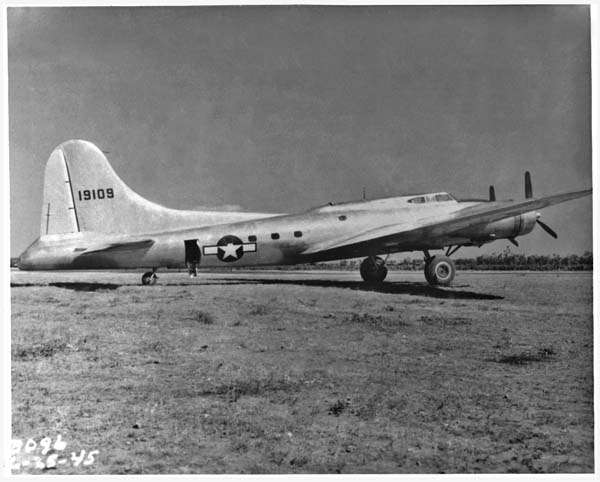
Of particular interest are the unusual windows installed aft of the cockpit.
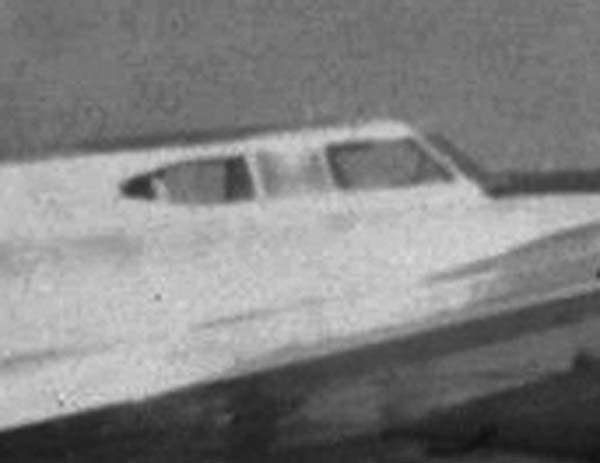
Also, the tail gunner compartment modification.
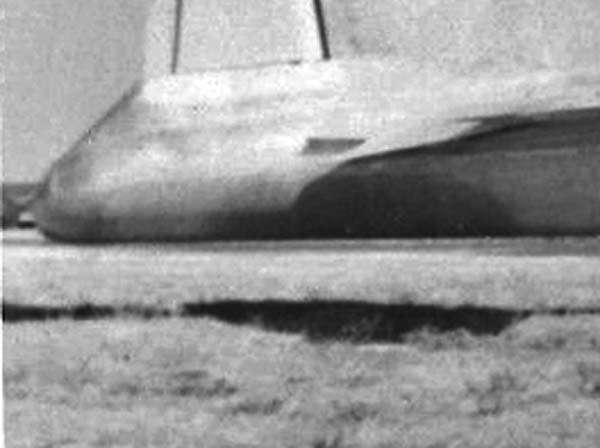
Additional windows were also installed in the aft fuselage, and it apparently carried the name Napoli Express. It evidently was a war weary B-17E put back into service as a transport, probably by the unit in its spare time.
Dave Osborne shows this airplane as having been an original 97th BG aircraft that went, it appears, to North Africa in May 1942, then assigned to the 12th AF and later 15th AF, presumably as the said transport. It ended up at Walnut Ridge after October 1945 and was, presumably, scrapped in 1946.
- B-17B 38-583 from 1943: S. Smisek sent this 1943 photo in of his dad, 1st Lt. Raymond B. Smisek, in the cockpit of B-17B 38-583 on the flight line at Hendricks Field, a major AAF B-17 training base in Florida. The photo is just too good not to use.
David Osborne's research shows this airplane as having been delivered in July 1940, and relegated to a training role for its service utilization until it was written off in October 1943, probably after an accident. Lt. Smisek went on to fly YB-40s for a gunnery training unit and, later, B-29s.
The top of the tail of Pacific veteran B-17E 41-2499, wearing no doubt its last combat camouflage scheme, can also be seen in the photo.
- A Few Vintage B-17 Photos: Chris Hoage sent in a bunch of photos of some vintage B-17s, B-25s, and Tallmantz airplanes, so I am sharing of few of them here.
First is a view of B-17G 42-102715 (N66573) operating as an air tanker for Black Hills Aviation, probably in the summer of 1969. This is the same airplane that crashed in Montana in July 1979, the wreckage of which is slated for recovery (see first item in this July 2015 update).
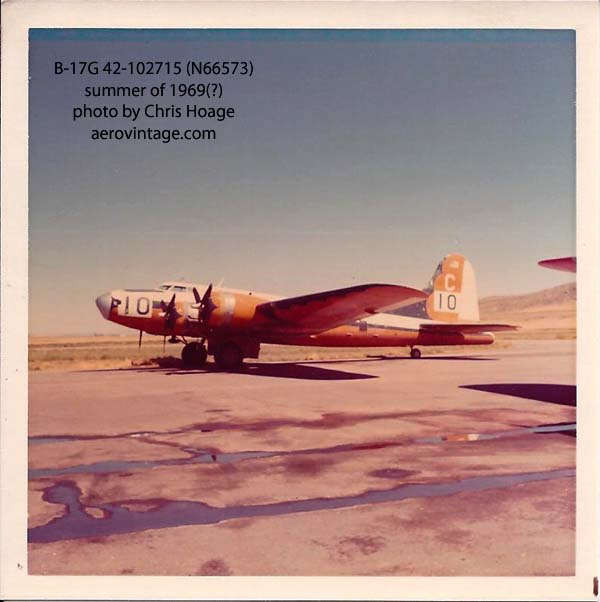
The second photo was taken the same time in 1969 and is a nice view of B-17G (and ex USCG PB-1G) 44-85828 (N9323R) as operated as an air tanker by Aero Flite. These operational photos of these tankers are nice to see. Chris relates how his father, believed to be the subject of this photo, was allowed to crawl around the B-17 as it sat on fire alert. This airplane survived its tanker duties and is now displayed by the 390th Memorial Museum at Tucson, Arizona.
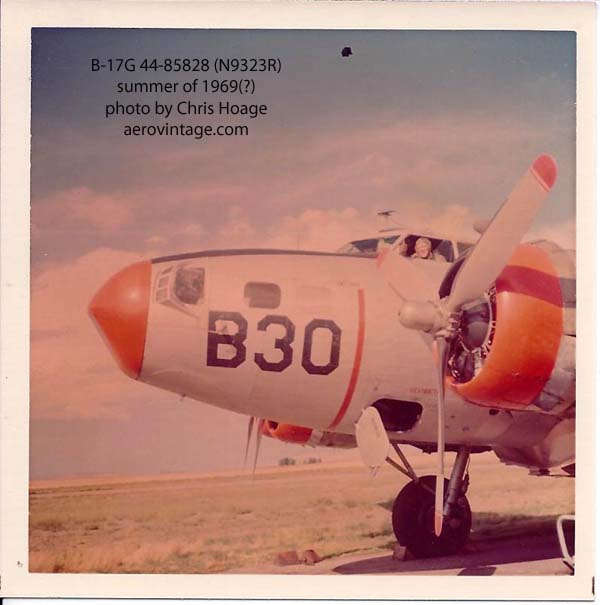
This third photo is a 1971 view of DB-17G 44-85738 parked along side California Highway 99 in the central valley town of Tulare, where it remains to this day. Things have changed quite a bit, though, as this view shows it in its original USAF markings and retaining such things as its upper top turret. This airplane was placed on display by the USAF in 1958.
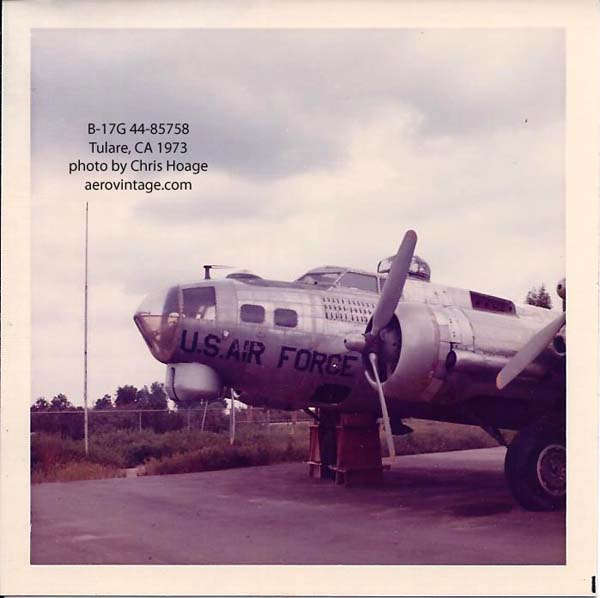
And, finally, a 1972 view of DB-17P 44-83525 (N83535), then marked as Balls Of Fire from a movie role, on the ramp at Tallmantz Aviation at Orange County Airport. It was not long after this photo was taken that the airplane was sold to Junior Burchinal and it left for Texas, a whole other story. This airplane survives in disassembled long-term storage with the Kermit Weeks collection.
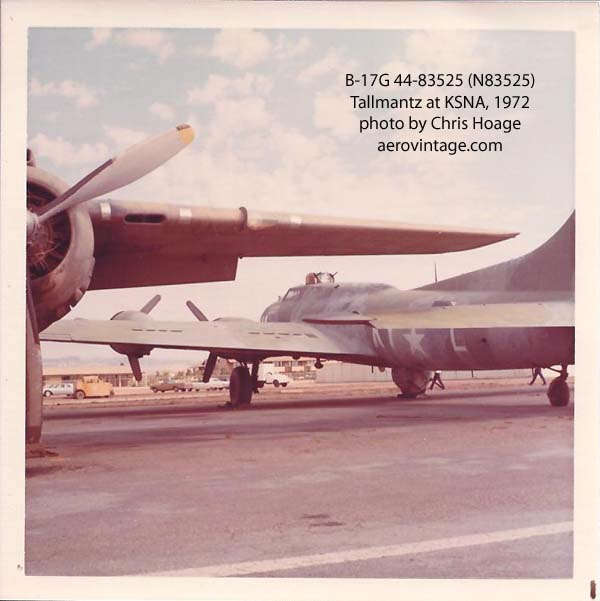
Thanks to Chris for sending these in. Other photos he sent in are sprinkled into the Aero Vintage B-25 and Tallmantz pages.
- Fantasy of Flight B-17s: Trevor McTavish offered two more recent photos of the two B-17s held by Kermit Weeks as part of the Fantasy of Flight collection in Florida, both taken in January 2014 but more current than what my locator page shows.
The first is of DB-17P 44-83525 (N83525), the same B-17 as shown in the last item above. This view shows the insurance-funded repair work done on the B-17 after Hurricane Andrew did its number. This airplane unfortunately is stuck in limbo and there are no plans nor any foreseeable plans for it to ever be reassembled. It would appear to be a tax and legal thing. Sad to say it may forever be storage(?).
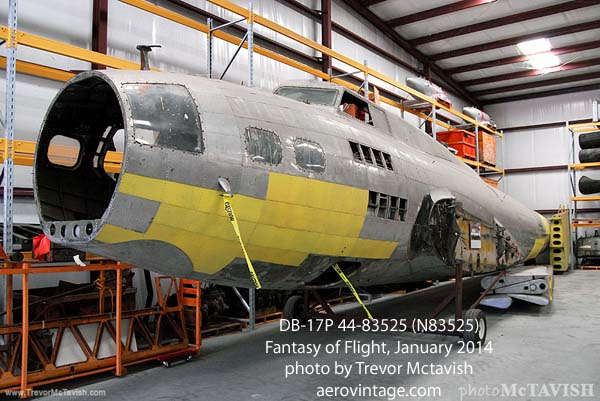
The second Fantasy of Flight B-17 is B-17G 44-83542 (N9324Z) that is, or was, on display in the museum facility, which has been closed for a year or two while it is being reworked. N9324Z was an Aero Union air tanker that crashed in July 1971 while working a fire. It was picked apart as spares support for nearly two decades before it went to Kermit Weeks. It was reassembled from parts and pieces to become this display. It is missing a wing section, but you get the idea.
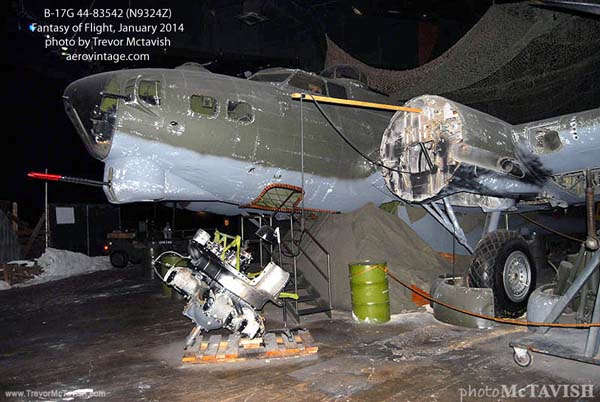
And here are other, more recent views, of N9324Z. No, wait, this is actually my RV-8 that is close to flying and somehow ended up with the same tail number as an old civil B-17.
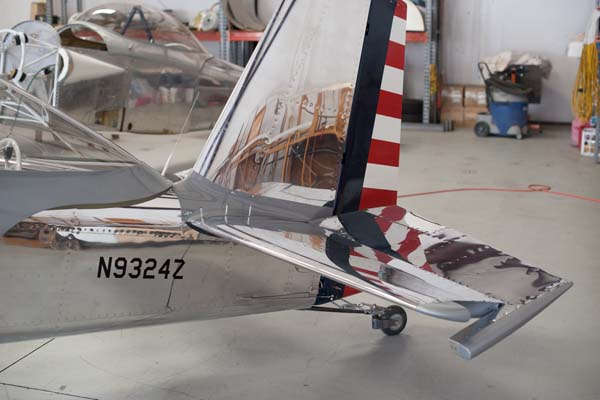
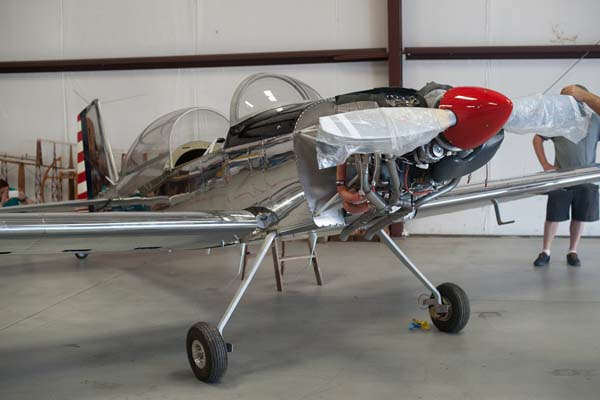
N9324Z flies again, eh? I digress, but it had to be done.
- Army Air Forces TB-17H Operations: Paul Eckstedt sent me a whole bunch of material pertaining to his dad's and uncle's service flying B-17Hs (later SB-17Gs) in the early postwar period with the Air Rescue Service. He sent in some photos from their own collections of three particular TB-17Hs, 44-83701, 44-83705, and 44-83709 flown by his dad, Lt. Duane "Duke" Ecksted, and uncle, Lt. Donald Evert.
The first photo had remarks on the back-- Our B-17 taken at Gander, Newfoundland July 1945 with our droppable boat which is 27 ft. long- weights 3800 lbs cost app $3,500:
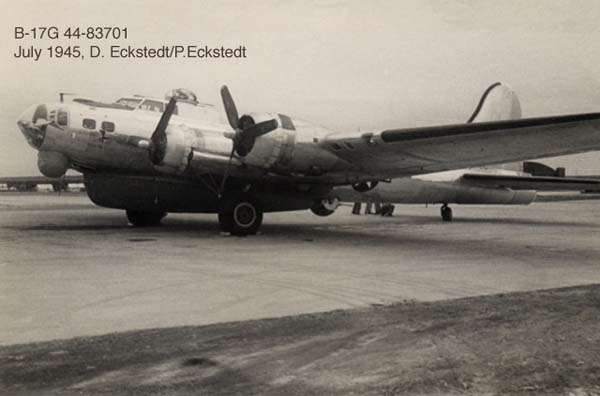
A nice color photo of TB-17H 44-83705:
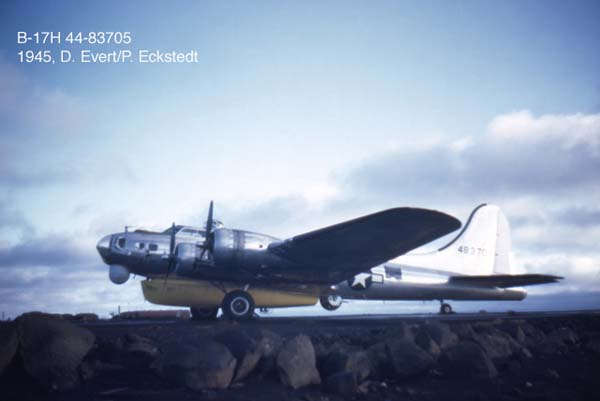
The notes on the back of this photo said Lt. Moore’s B-17, formation over Gander. July 1945, taken from our ship:
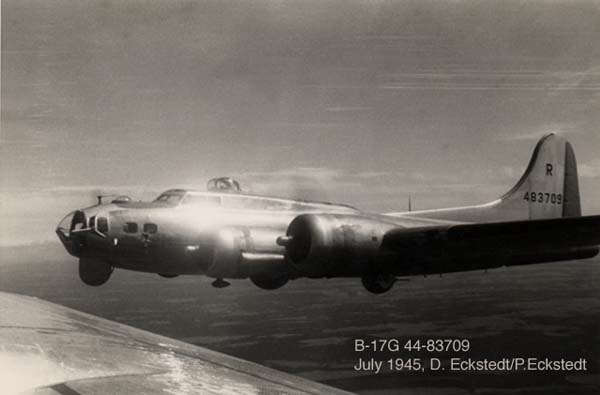
Also of particular interest is this narrative that Paul wrote from the memories of his dad and uncle about some of their experiences in the AAF. Note the reference to the Memphis Belle, 41-24485, then on training duty.
My father and my uncle met during the course of basic training. Their paths crossed in Florida in late 1944 and they were based at Avon Park. After their training in Air Sea Rescue, both picked up their new B-17’s in June of 1945 and flew their aircraft and crew to their assigned bases. My father was stationed at Ernest Harmon in Newfoundland and my uncle was stationed at Reykjavik Iceland. My father also had an opportunity fly and be checked out in PBY’s and C-47 transports which helped keep his flight hours up. My father had about 1200 hours total when he left the service in December of 1945. My uncle stayed connected to the service up to his retirement from the Air Force Reserves in the late 1970’s as a Major.
My uncle passed away in 2012 at the age of 89. My father just celebrated his 91st birthday this March and currently lives in Sonora, CA.
During their time in Florida, they both flew the Memphis Belle after it had returned from its Bond Drive tour. It was assigned to the base for training and ferrying assignments. In fact, my uncle flew it down to Havana, Cuba for a training run. Both said it was in pretty rough shape at that time.
During the latter part of the war, my father operated his aircraft with a full crew and armaments. When the war ended in August they removed their weapon systems and operated with a smaller crew of about 5 or 6. I noticed on one of the internet sites that it lists the last SB-17 in service to be (44-83701) and also as being withdrawn from service in 1956 from its location in the Azores.
Thanks to Paul for putting together this well-documented material. He also has more photos and logbooks and other material he has gathered on his dad's and uncle's service.
For the curious at heart, the fates of the three TB-17Hs: 44-83701 was modified to a QB-17N status in 1956 and destroyed in a missile test in 1957; 44-83705 was withdrawn from service in 1954 and probably scrapped at the Ogden Air Depot in Utah in 1955; and 44-83709 was withdrawn from service in 1948 and presumably scrapped, possibly at the Brookley Air Depot in Alabama, shortly afterwards.
B-17 News Archive
2018 B-17 News
2017 B-17 News
2016 B-17 News
2015 B-17 News
2014 B-17 News
2013 B-17 News
2012 B-17 News
2011 B-17 News
2010 B-17 News
2009 B-17 News
2008 B-17 News
2007 B-17 News
2006 B-17 News
2005 B-17 News
2004 B-17 News
2003 B-17 News
2002 B-17 News
1997-2001 B-17 News
Back to B-17 Information
Back to the Main Page
Updated: - Grissom B-17G On the Move: In May 2015, it was announced that the long-displayed B-17G, 44-83690 and otherwise known as Miss Liberty Belle, would be moving to the Museum of Aviation at Robins AFB, Georgia, in August 2015. The B-17G, actually an ex-USAF DB-17P drone controller, has been on outdoor display at Grissom AFB (formerly Bunker Hill AFB) in Indiana since 1961.
